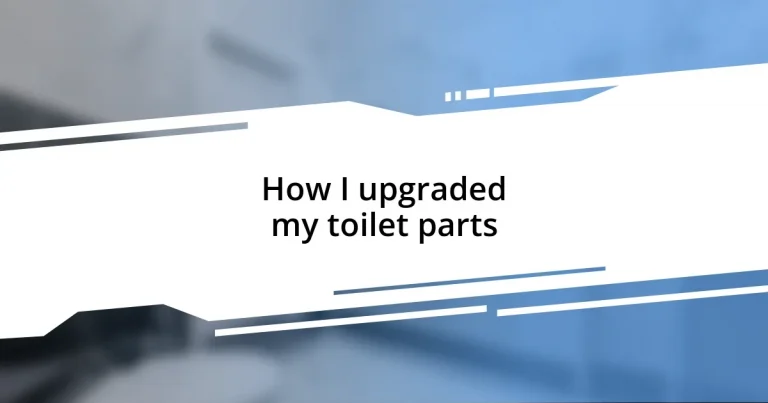Key takeaways:
- Assess and inspect toilet issues promptly to avoid larger plumbing problems.
- Select compatible, high-quality replacement parts to enhance toilet performance and longevity.
- Gather necessary tools before starting upgrades to streamline the DIY process.
- Regular maintenance, including checking the flapper and water levels, can prevent unexpected issues and save on water bills.

Assessing Your Toilet Issues
When I noticed my toilet making strange gurgling noises, I felt a mix of irritation and curiosity. Those sounds were more than just a nuisance; they signaled potential plumbing problems. Have you ever experienced that unsettling feeling when your toilet behaves unexpectedly?
One day, I discovered water pooling around the base of my toilet, which prompted a thorough inspection. I realized that assessing the situation meant looking for loose connections or cracks. As I crouched down to investigate, I was struck by how often we overlook such straightforward issues until they escalate.
Don’t underestimate the importance of checking the flush mechanism. I once assumed it was just a weak flush, but upon further inspection, I found a worn flapper and a corroded chain. How often do we overlook the simple fix? Sometimes, the smallest adjustments can save you from major headaches down the line.

Choosing the Right Replacement Parts
Choosing the right replacement parts for your toilet is crucial, and I can’t stress enough how it pays off to do your homework. The first time I needed to replace my flapper, I just grabbed the cheapest option available. That was a major mistake. The wrong part not only failed to seal properly but also led to more leaks and even higher water bills! I learned that investing time in identifying parts compatible with my toilet model made all the difference in the long run.
Here are a few tips to keep in mind when selecting replacement parts:
- Check the Manufacturer’s Specifications: Always refer to your toilet’s manual or look for the manufacturer’s part numbers. Compatibility is key.
- Material Matters: Consider parts made from durable materials like rubber or silicone for the flapper to ensure longevity.
- Quality Over Cost: While it’s tempting to go for the cheapest option, sometimes higher-quality parts provide better performance and longevity.
- Consider Upgrades: When replacing parts, explore options that offer improved efficiency, such as low-flow toilets or dual-flush systems, which can save water and money over time.
By making informed choices, you enable yourself to create a more reliable and efficient toilet system. Trust me, these little details can transform a headache into a breeze!

Tools Needed for Toilet Upgrade
When I decided to upgrade my toilet parts, I quickly realized that having the right tools on hand made the entire DIY process smoother and less daunting. I gathered a basic toolkit that included a adjustable wrench, a screwdriver set, and a plunger. It’s funny; I once thought a plunger was just a tool for emergencies, but it became indispensable during the upgrade as I encountered minor obstructions. Did you know that a simple ridged plunger works wonders for removing clogs while making any necessary adjustments?
For those looking to take on their own toilet upgrades, here’s a handy table comparing essential tools and their functions. I’ve often found having all necessary tools ready makes the work more enjoyable, allowing me to focus on the task rather than running around the house searching for something I need.
| Tool | Function |
|---|---|
| Adjustable Wrench | Used for tightening or loosening nuts and bolts. |
| Screwdriver Set | Essential for removing and tightening screws on tank parts. |
| Plunger | Helps clear blockages in the toilet drain. |
| Pipe Wrench | Ideal for gripping and turning pipes or fittings. |
| Bucket | To catch any water spills during the upgrade. |
Don’t forget a bucket! I learned this the hard way. The first time I attempted a repair, I didn’t have one nearby and ended up with a small puddle on the bathroom floor—definitely not the best way to keep things tidy! Each tool serves a purpose, ensuring every step of your upgrade goes off without a hitch. Planning ahead and assembling your toolkit can significantly reduce the time spent scrambling for what you need. Trust me, the satisfaction from a successful self-upgrade is unmatched!

Step by Step Installation Guide
When I began the installation of my new toilet parts, the first thing I did was turn off the water supply. It may sound like an obvious step, but trust me, it’s one you don’t want to skip unless you enjoy unexpected waterworks! Once I twisted that valve, I removed the tank lid carefully—this part can be heavy, and I learned to place it somewhere safe to avoid mishaps.
Next, I tackled the tank components. I started by detaching the old flapper. I remember questioning whether I had the right tools while fumbling with the old parts, but my trusty adjustable wrench saved the day. After loosening a few screws, the flapper came right off, and I paused for a moment to take a look at the old piece. It was a bit grimy! Replacing it felt almost cathartic, making me realize how important hygiene is in those unseen regions of a toilet.
As I installed the new flapper, I made sure it fit snugly against the valve seat. I remember having a moment of doubt, wondering if I was doing it right. But seeing how effortlessly it pressed down, sealing properly, filled me with confidence. After securing all components and reattaching the tank, I turned the water back on and held my breath. The rush of water filling the tank was exhilarating as I quickly checked for leaks—a proud DIY victory!

Common Mistakes to Avoid
One common mistake I see people make is neglecting to double-check measurements before purchasing new parts. I learned this the hard way—after getting home with what I thought were the perfect replacements, only to find they didn’t fit at all! It’s like trying to fit a square peg into a round hole; it just doesn’t work and ends up wasting time and money.
Another pitfall is skipping the cleaning step before installing new components. During my upgrade, I was eager to put in the new parts and initially overlooked scrubbing the tank and bowl. However, once I realized my mistake, I went back and cleaned everything thoroughly. It’s astonishing how much grime can build up over time, and neglecting this can lead to poor performance and even health concerns. Have you ever thought about how important it is to maintain a clean environment, even in places we don’t often see?
Lastly, not reading the installation instructions can lead to frustration. Honestly, I felt a bit silly when I ignored the manual for the replacement parts and ended up having to backtrack. Taking a moment to read through the directions can save you from unnecessary headaches later on. I’ve found that slowing down and following the steps carefully often leads to a more successful outcome, and it helps you feel more accomplished at the end of the project.

Maintenance Tips for Longevity
Maintaining the longevity of your toilet parts is easier than you might think. One step I always take is to keep an eye on the water level in the tank. When I first upgraded my toilet, I noticed the water level fluctuating. A quick adjustment with the float arm made a world of difference, preventing potential leaks and ensuring flush efficiency. Have you checked your water level lately? It can save you a headache down the line!
Regularly inspecting the flapper is another tip I swear by. Early on, I didn’t pay much attention to this little part, but after experiencing a phantom flush that kept me up at night, I learned my lesson. Now, I make it a habit to open the tank lid and examine the flapper for wear and tear every few months. Trust me, a simple visual check can save you from unexpected surprises and costly water bills. It’s a small effort that yields great peace of mind.
Finally, consider replacing small parts proactively rather than reactively. I remember when I had to replace the fill valve only after it went kaput during a dinner party. Talk about embarrassing! Now, I take a moment each year to replace items like the flapper and fill valve preemptively. This way, I avoid the hassle of last-minute repairs and keep everything running smoothly. How often do you review your toilet’s components? A little foresight goes a long way in avoiding unwanted surprises!

Benefits of Upgrading Toilet Parts
Upgrading toilet parts can significantly enhance your overall bathroom experience. I remember feeling so pleased after installing a new dual-flush system. Not only did it reduce water usage—something I was passionate about—but it also provided me with the satisfaction of knowing I was doing my part for the environment. It’s incredible how a simple change can lead to such a positive impact, both on my utility bills and my carbon footprint.
One of the major benefits of upgrading is improved functionality. I learned this firsthand when I swapped out an old, sluggish fill valve for a modern one. The difference was night and day! The tank filled up quickly and quietly, making my mornings less stressful. Have you ever been frustrated by a toilet that takes forever to refill? I know I have, and upgrading really solved that irritation.
Another aspect that surprised me was the increase in reliability. After upgrading the flapper, I no longer dealt with annoying leaks that had haunted me for years. It felt like a weight lifted off my shoulders. How reassuring it is to have a toilet that works smoothly without unexpected surprises! It’s these little victories in home improvement that really bring a sense of pride and peace of mind in daily life.














